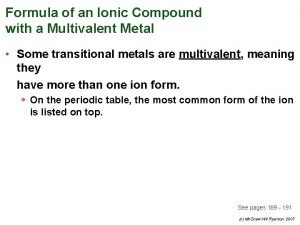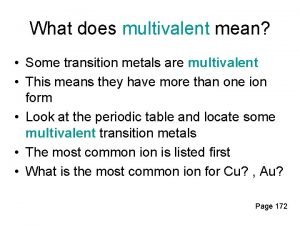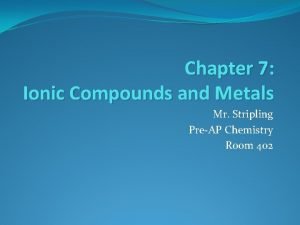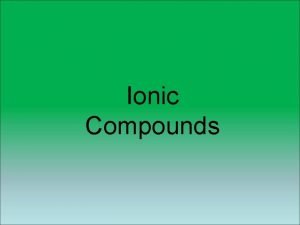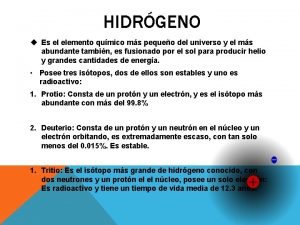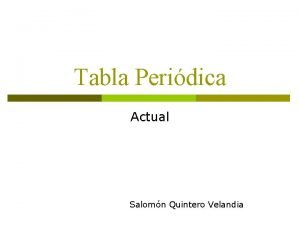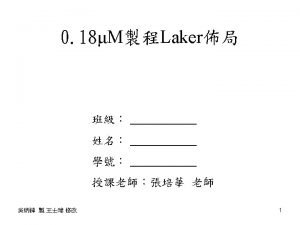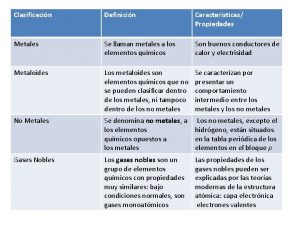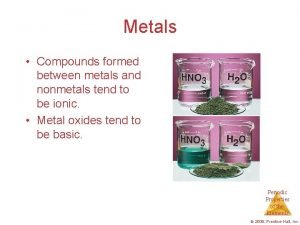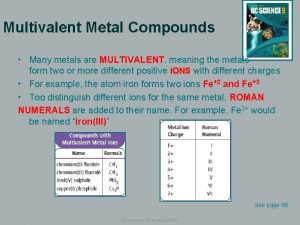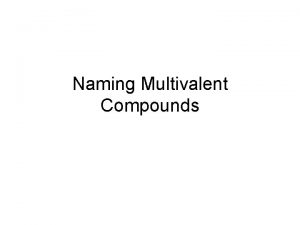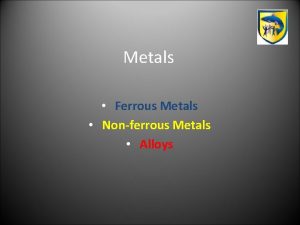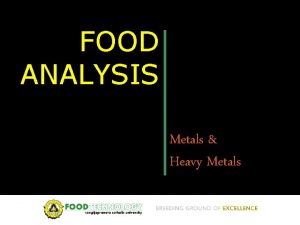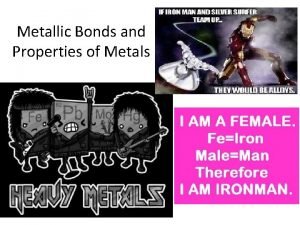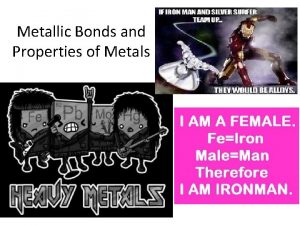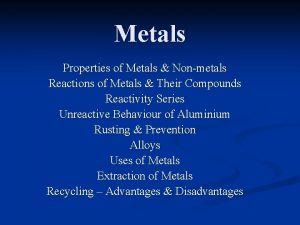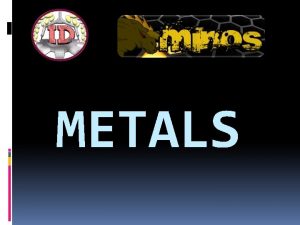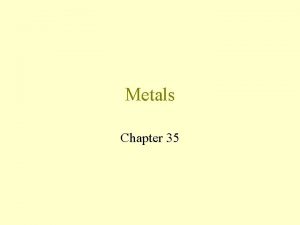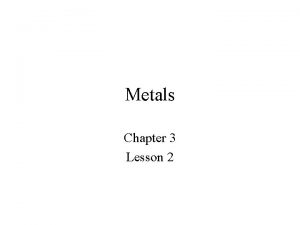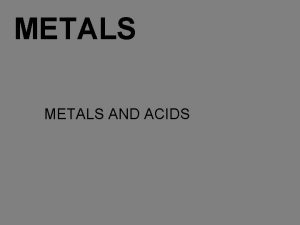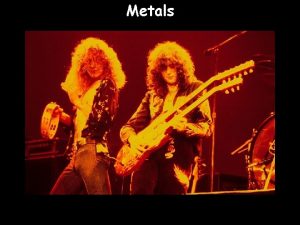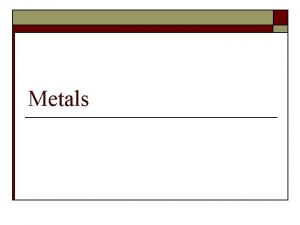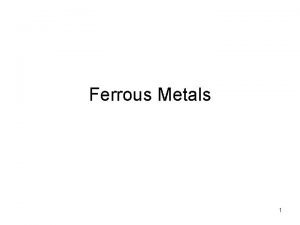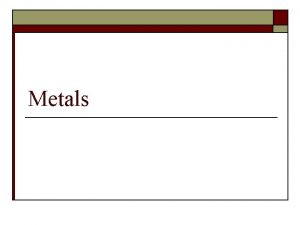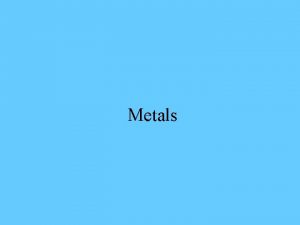COMPOUNDS WITH MULTIVALENT METALS MultiValent Metal Compounds Many
































- Slides: 32

COMPOUNDS WITH MULTIVALENT METALS

Multi-Valent Metal Compounds Many important metals are multivalent • “multi” means many • “valent” refers to the capacity to bond (think about the valence shell…) So it means that the element has many ways to bond Multivalent metals can form 2 or more different positive ions with different ion charges

Example: Iron has two ion charges: 3+ and 2 as either. -The periodic table shows the most charge first --> Fe 3+ is more common than Recall: metals are blue ones here. In ionic compound, w name the metal fir

When we’re talking about multivalent metals, we need make sure we’re clear which ion form we’re talking about. To do this, we use Roman Numerals We would use Roman Numerals for copper (Cu) because it can have a charge of either 2+ or 1+ as an ion, and we’d need to specify which one We wouldn’t use Roman Numerals for calcium (Ca) because it always has a charge of 2+ as an ion So how do we know which one? ?

How to Write and Say Them… Examples Fe 3+ Written: iron(III) Pronounced “iron three” Fe 2+ Written: iron(II) Pronounced “iron two” Pb 4+ Written: lead(IV) Pronounced “lead four” Cu+ Written: copper(I) Pronounced “copper one”

PART A: WRITING FORMULAS WITH MULTIVALENT METALS

Writing Chemical Formulas w/ Multivalent Metals • The Roman Numeral after the metal will tell you which ion charge to use Example: Chromium fluoride Cr+3 or Cr+2 ? ? F-1 Example: Chromium(III) fluoride Cr+3 Cr. F 3 F-1

copper(I) iodide • Cu. I Writing Formulas of Multivalent Ionic Compounds Try some tin(II) nitride • Sn 3 N 2 iron(II) phosphide • Fe 3 P 2 examples: tin(IV) nitride • Sn 3 N 4

Practice a few…

Solutions

PART B: NAMING COMPOUNDS WITH MULTIVALENT METALS

NAMING COMPOUNDS WITH MULTIVALENT METALS It’s important EVERY time you write the metal in the compound, you stop to CHECK if it’s multivalent!! • If it IS, you need to include the Roman Numeral • If it IS NOT multivalent, do NOT include Roman Numeral!

No Likely

Examples Cu 3 P copper(I) phosphide ? y? Mn. O 2 Wh manganese(IV) oxide Mn+4 and O 2 - Mn 2 O 4 which simplifies to Mn. O 2 It’s not Mn+2 and O 2 - Mn 2 O 2 which simplifies to Mn. O

Practice a few…

Solutions

COMPOUNDS WITH POLYATOMIC IONS

MOLECULAR IONS // POLYATOMIC IONS • Covalent & ionic bonds can be found in the same compound! • It is possible for some molecules (i. e. compounds) to gain or lose electrons (ionic bonding) as their atoms combine to form a molecule (covalent bonding) • In doing so, they become a molecular ion, called a polyatomic ion.

Polyatomic Ions Example: Breathalyzer Test • In one type of Breathalyzer test, an orange liquid (potassium dichromate) turns green in the presence of alcohol. • Potassium dichromate contains potassium ions and dichromate ions • Dichromate ion has the formula Cr 2 O 7 2 - 2 atoms of chromium and ___ 7 atoms of • ___ 2 oxygen; has a charge of ____ • The atoms oxygen and chromium are connected by covalent bonds to make dichromate • The negatively charged dichromate ion is connected by ionic bonds to positive potassium ions in the potassium dichromate.

PART A: WRITING FORMULAS OF COMPOUNDS WITH POLYATOMIC IONS

FORMULAS OF POLYATOMIC IONS We already learned that some molecules can gain or lose electrons to become polyatomic ions Because a polyatomic ion carries an electric charge, it cannot exist on its own. It is always paired up with ions that carry an opposite charge.

FORMULAS OF POLYATOMIC IONS Polyatomic ions often have common names, so if you do not see the word listed as an element on the periodic table, chances are it is a polyatomic ion so refer to the table of common polyatomic ions

Example: sodium chromate Na + Cr. O 4 2 W ne e d ed on th to ’t e “ 1 put ” Na 2 Cr. O 4 Answer: Na 2 Cr. O 4

Example: tin(II) hydroxide Sn NEED brackets to ensure it’s two of the whole hydroxide molecule, not just the “H” 2+ OH - Sn (OH ) 2 Answer: Sn(OH)2

Practice a few…

Solutions

PART B: NAMING COMPOUNDS WITH POLYATOMIC IONS

Example: Na. CH 3 COO sodium acetate That’s it!

Example: Cr(OH)3 chromium(III) hydroxide WAIT!! Don’t forget to check if you’re using a multivalent metal. Is chromium multivalent? YES!! So we need a Roman Numeral to indicate which ion we’re talking about Answer: chromium(III) hydroxide

Example: Ba 3(PO 3)2 barium phosphite Check: is the metal (barium) multivalent? Nope! Answer: barium phosphite

Part B: Practice a few…

Part B: Solutions
 Is titanium multivalent
Is titanium multivalent Examples of multivalent ionic compounds
Examples of multivalent ionic compounds Multivalent compounds worksheet
Multivalent compounds worksheet What are multivalent metals
What are multivalent metals Rs chemical name
Rs chemical name Natural science grade 7 term 2 notes pdf
Natural science grade 7 term 2 notes pdf Metals nonmetals and metalloids periodic table
Metals nonmetals and metalloids periodic table Metals and non metals grade 5
Metals and non metals grade 5 Ferrous vs non ferrous
Ferrous vs non ferrous Metal examples
Metal examples Compare metals nonmetals and metalloids
Compare metals nonmetals and metalloids Chapter 7 ionic compounds and metals
Chapter 7 ionic compounds and metals Ionic compounds properties
Ionic compounds properties Chapter 7 ionic compounds and metals assessment answer key
Chapter 7 ionic compounds and metals assessment answer key Chemistry chapter 7 ionic and metallic bonding
Chemistry chapter 7 ionic and metallic bonding Ionic compounds containing transition metals
Ionic compounds containing transition metals Ionic compounds have
Ionic compounds have Non metals
Non metals Acidity trends periodic table
Acidity trends periodic table Pure substances on the periodic table
Pure substances on the periodic table El sodio es metal o no metal
El sodio es metal o no metal Melting point of diamond
Melting point of diamond P
P Pmos nwell
Pmos nwell Chemical bond def
Chemical bond def Metal non metal liquid venn diagram
Metal non metal liquid venn diagram Metal and nonmetal
Metal and nonmetal Metales no metales y metaloides
Metales no metales y metaloides Compounds formed between metal and nonmetals
Compounds formed between metal and nonmetals Ionic covalent and metallic bonds venn diagram
Ionic covalent and metallic bonds venn diagram Many sellers and many buyers
Many sellers and many buyers Erd vs erm
Erd vs erm Many to many communication
Many to many communication

